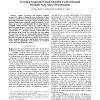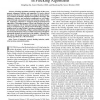344 search results - page 62 / 69 » Mobile Robot Navigation Support in Living Environments |
ICRA
2009
IEEE
15 years 6 months ago
2009
IEEE
² Similar to humans and primates, artificial creatures like robots are limited in terms of allocation of their resources to huge sensory and perceptual information. Serial process...
ICRA
2007
IEEE
15 years 6 months ago
2007
IEEE
Abstract— This paper presents a novel use of spectral clustering algorithms to support cases where the entries in the affinity matrix are costly to compute. The method is increm...
120
click to vote
SECON
2010
IEEE
14 years 9 months ago
2010
IEEE
Existing solutions to carrier-based sensor placement by a single robot, in a bounded unknown region of interest (ROI), do not guarantee full area coverage and/or do not terminate. ...
119
click to vote
DRUMS
1998
Springer
15 years 3 months ago
1998
Springer
Autonomous robots need the ability to move purposefully and without human intervention in real-world environments that have not been speci cally engineered for them. These environm...
TFS
2008
14 years 11 months ago
2008
Abstract--Flocking algorithms essentially consist of three components: alignment, cohesion, and separation. To track a desired trajectory, the flock center should move along the de...



